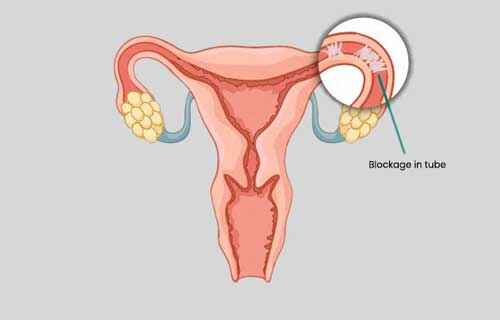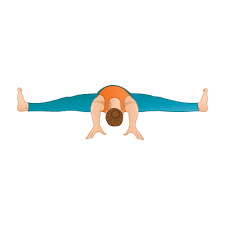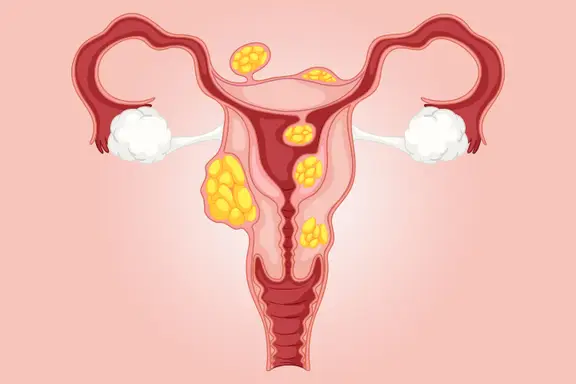Introduction : Blocked Fallopian Tubes

Blocked fallopian tubes represent a significant challenge for many women facing fertility issues, often leading to emotional distress and a sense of helplessness. The fallopian tubes play a crucial role in a woman’s reproductive health as they serve as the pathway for the sperm to reach the egg and for the fertilized egg to travel to the uterus. When these tubes are blocked, the natural process of conception can be hindered, making it challenging to achieve pregnancy.
Yoga for Blocked Fallopian Tubes
Realising the need for alternative, less invasive solutions, many women turn to natural remedies alongside conventional medical treatments. In recent years, there has been a growing interest in holistic approaches to fertility, emphasising the interconnectedness of physical, emotional, and mental health. One such practice that garners attention is yoga, an ancient discipline that combines physical postures, breath control, and mindfulness.
This comprehensive guide aims to enlighten you about the symptoms, causes, and treatments related to blocked fallopian tubes, emphasising the role of yoga as a natural remedy for enhancing fertility. You will discover common signs indicating a potential blockage, delve into the multifaceted causes behind this condition, and explore both conventional and natural treatments that can support your reproductive journey.
Furthermore, we will introduce you to specific yoga asanas that are particularly beneficial for stimulating reproductive health and optimising the function of fallopian tubes.

Symptoms of Blocked Fallopian Tubes
Common Symptoms and Signs
Blocked fallopian tubes often show no symptoms, making diagnosis challenging without medical testing. Many women only discover the issue when they struggle to conceive. However, some signs might suggest a blockage:
- Painful periods: Discomfort during menstruation might indicate tubal issues, especially if the pain is severe and persistent.
- Pain during intercourse: Persistent pain during or after sexual intercourse can be a sign of blocked fallopian tubes or related reproductive health issues.
- Abnormal vaginal discharge: Unusual discharge, particularly if it is thick, discolored, or has a foul odor, might indicate an infection causing blockage.
- Pelvic pain: Chronic pelvic pain, especially on one side, can suggest a problem with the fallopian tubes. This pain may be constant or intermittent and can worsen during certain activities.
When to Seek Medical Advice
If you experience any of these symptoms or have trouble conceiving, it is important to consult a healthcare provider. Early diagnosis and treatment can improve the chances of conception and overall reproductive health. A doctor can perform tests, such as hysterosalpingography (HSG) or laparoscopy, to diagnose and treat blocked fallopian tubes effectively.
Major Causes and Risk Factors of Blocked Fallopian Tubes
Several factors can lead to blocked fallopian tubes:
- Pelvic inflammatory disease (PID): Infections, often caused by sexually transmitted infections, leading to inflammation and scarring of the fallopian tubes.
- Endometriosis: Tissue growth outside the uterus can block tubes. The tissue can attach to the fallopian tubes and cause blockages, preventing the egg and sperm from meeting.
- Fibroids: Noncancerous growths called fibroids can obstruct fallopian tubes. These growths can develop in the uterine wall and block the opening of the fallopian tubes.
- Previous surgeries: Scar tissue from abdominal or pelvic surgeries can cause blockages. Surgeries involving the fallopian tubes, such as those for ectopic pregnancy or sterilization, can increase the risk.
- Sexually transmitted infections (STIs): Some STIs, like chlamydia and gonorrhea, can cause inflammation and scarring, leading to blocked fallopian tubes.
How Lifestyle and Health Conditions Impact Fallopian Tube Health
Unhealthy lifestyle choices and certain health conditions can increase the risk of blocked fallopian tubes:
- Smoking: Reduces blood flow and damages reproductive organs. The toxins in cigarettes can harm the fallopian tubes and reduce their ability to function properly.
- Obesity: Hormonal imbalances caused by excess weight can lead to blockages. Maintaining a healthy weight through diet and exercise is crucial for reproductive health.
- Poor diet: Lack of essential nutrients affects reproductive health. A diet rich in fruits, vegetables, and lean proteins can support the health of the fallopian tubes.
- Chronic stress: Impacts overall health and fertility. High stress levels can lead to hormonal imbalances, affecting the reproductive system.
Maintaining a healthy lifestyle, managing stress, and seeking prompt medical care for infections can help preserve the health of the fallopian tubes.
Cure with Diet and Lifestyle Changes

Adopting a healthy diet and making lifestyle changes can positively impact the health of your fallopian tubes. Here are some recommendations:
- Anti-inflammatory diet: Consuming foods that reduce inflammation can help maintain the health of the fallopian tubes. Include foods rich in omega-3 fatty acids like salmon, walnuts, and flaxseeds. Also, incorporate a variety of fruits and vegetables, especially leafy greens, berries, and citrus fruits.
- Hydration: Staying hydrated is essential for overall health, including reproductive health. Drink at least eight glasses of water a day to help flush out toxins and maintain bodily functions.
- Avoid processed foods: Processed and sugary foods can lead to inflammation and hormonal imbalances. Opt for whole, unprocessed foods to support your reproductive health.
- Exercise: Regular physical activity helps improve circulation and reduce stress. Aim for at least 30 minutes of moderate exercise, such as brisk walking, swimming, or yoga, five times a week.
- Avoid smoking and limit alcohol: Smoking and excessive alcohol consumption can damage reproductive organs and reduce fertility. Quit smoking and limit alcohol intake to improve your chances of conception.
Yoga as a Natural Cure for Blocked Fallopian Tubes
How Yoga Enhances Reproductive Health
Yoga is a holistic practice that not only promotes physical fitness but also enhances mental and emotional well-being. For women with blocked fallopian tubes, yoga can provide several benefits:
- Improved blood circulation: Yoga poses stimulate blood flow to the pelvic region, which can help maintain the health of the fallopian tubes and reproductive organs.
- Stress reduction: Chronic stress can negatively impact reproductive health. Yoga promotes relaxation and reduces stress, which can improve hormonal balance and overall fertility.
- Hormonal balance: Certain yoga poses and breathing techniques can help regulate hormones, supporting reproductive health.
- Detoxification: Yoga helps the body eliminate toxins, which can improve overall health and reproductive function.
Benefits of Yoga for Fallopian Tube Health
Practicing yoga regularly can offer specific benefits for the health of your fallopian tubes:
- Enhanced flexibility and strength: Yoga strengthens the muscles around the reproductive organs, supporting their proper function.
- Improved digestion: Good digestive health is crucial for overall well-being. Yoga poses that stimulate the digestive system can help improve nutrient absorption and support reproductive health.
- Emotional well-being: Yoga promotes a sense of calm and emotional stability, which is important for maintaining hormonal balance and reproductive health.
Top 10 Yoga Asanas recommended for Blocked Fallopian Tubes
Supta Baddha Konasana (Reclining Bound Angle Pose)
Supta Baddha Konasana, or Reclining Bound Angle Pose, is a restorative yoga pose that opens the hips, groin, and inner thighs. This pose promotes relaxation and enhances blood flow to the pelvic region, making it highly beneficial for reproductive health.
To perform this pose, lie on your back, bring the soles of your feet together, and let your knees fall open to the sides. Place your arms comfortably by your sides or above your head, and focus on deep, rhythmic breathing.
Benefits for Reproductive Health:
- Opens the pelvic region: This pose gently stretches the inner thighs, groin, and hips, which helps in improving blood circulation to the reproductive organs.
- Reduces stress and anxiety: By promoting relaxation and calming the nervous system, this pose helps to balance hormones and support reproductive health.
- Enhances blood flow: Improved circulation to the pelvic area can help nourish the fallopian tubes and other reproductive organs, supporting their proper function.
- Supports hormonal balance: Relaxation and deep breathing in this pose can help reduce stress hormones, promoting a healthy hormonal balance.

Bhujangasana (Cobra Pose)
Bhujangasana, or Cobra Pose, is a rejuvenating backbend that stretches the spine and opens the chest. This pose is particularly effective in stimulating the abdominal organs, including the reproductive organs.
To perform Cobra Pose, lie on your stomach with your hands placed under your shoulders. Press into your hands to lift your chest off the ground while keeping your elbows close to your body and your legs extended.
How It Stimulates Reproductive Organs:
- Stretches the abdominal region: Cobra Pose stretches and strengthens the abdominal muscles, enhancing the function of the reproductive organs.
- Improves blood flow: The pose increases circulation to the pelvic area, which can help in nourishing the fallopian tubes and other reproductive organs.
- Reduces stress: This pose promotes relaxation and stress relief, which is crucial for maintaining hormonal balance and supporting reproductive health.
- Enhances spinal health: A healthy spine supports the nervous system, which in turn helps regulate the reproductive system and improve overall fertility.

Setu Bandhasana (Bridge Pose)
Setu Bandhasana, or Bridge Pose, is a versatile yoga pose that strengthens the back, glutes, and legs while opening the chest and improving blood circulation.
To perform this pose, lie on your back with your knees bent and feet hip-width apart. Press into your feet to lift your hips off the ground, creating a bridge shape with your body. Clasp your hands under your back for added support and lift.
Enhancing Blood Circulation to the Uterus:
- Strengthens the lower body: Bridge Pose engages the glutes, hamstrings, and lower back muscles, providing support to the pelvic region and reproductive organs.
- Opens the chest: This pose expands the chest and improves lung capacity, which enhances overall oxygenation and blood flow to the entire body, including the reproductive organs.
- Increases blood flow: Lifting the hips in this pose helps to boost circulation to the uterus and fallopian tubes, supporting their health and function.
- Relieves stress: By promoting relaxation and reducing stress, Bridge Pose helps balance hormones and improve reproductive health.

Viparita Karani (Legs Up the Wall Pose)
Viparita Karani, or Legs Up the Wall Pose, is a restorative inversion that promotes relaxation and improves circulation. To perform this pose, lie on your back with your legs extended up the wall and your hips close to the wall. Relax your arms by your sides and focus on deep, even breathing.
Relaxation and Improved Circulation:
- Promotes relaxation: This pose is highly calming and helps to reduce stress and anxiety, which can support hormonal balance and reproductive health.
- Improves circulation: By elevating the legs, this pose enhances blood flow to the pelvic region, nourishing the fallopian tubes and other reproductive organs.
- Reduces swelling: Viparita Karani can help reduce swelling in the legs and feet, which can be beneficial for overall circulation and health.
- Supports detoxification: Improved blood flow and relaxation in this pose can aid the body’s natural detoxification processes, supporting reproductive health.

Paschimottanasana (Seated Forward Bend)
Paschimottanasana, or Seated Forward Bend, is a calming pose that stretches the entire back body, including the spine, hamstrings, and lower back. To perform this pose, sit with your legs extended in front of you. Reach forward with your hands, aiming to hold your feet or shins, and gently fold over your legs while maintaining a straight spine.
Stress Relief and Stimulation of Reproductive Organs:
- Stretches the lower back: This pose releases tension in the lower back, which can help improve circulation to the reproductive organs.
- Promotes relaxation: By calming the mind and reducing stress, Seated Forward Bend helps to balance hormones and support reproductive health.
- Stimulates the abdominal organs: The forward fold compresses and massages the abdominal area, stimulating the digestive and reproductive organs.
- Improves flexibility: Regular practice of this pose increases flexibility in the spine and hamstrings, which supports overall physical health and well-being.

Shalabhasana (Locust Pose)
Shalabhasana, or Locust Pose, is a strengthening backbend that targets the lower back and abdominal muscles. To perform this pose, lie on your stomach with your arms by your sides. Lift your head, chest, and legs off the ground simultaneously, engaging your lower back and glutes.
Strengthening the Lower Back and Abdominal Organs:
- Strengthens the lower back: Locust Pose engages the muscles of the lower back, providing support to the spine and reproductive organs.
- Stimulates the abdominal organs: This pose compresses the abdomen, stimulating the digestive and reproductive systems and enhancing their function.
- Improves posture: By strengthening the back muscles, this pose helps improve posture, which can positively impact overall health and well-being.
- Increases energy: Practicing Locust Pose can help increase energy levels and reduce fatigue, supporting overall reproductive health.

Sarvangasana (Shoulder Stand)
Sarvangasana, or Shoulder Stand, is an inversion that promotes overall health and well-being. To perform this pose, lie on your back and lift your legs and hips off the ground, supporting your lower back with your hands. Extend your legs straight up towards the ceiling, keeping your body aligned and balanced.
Balancing Hormones and Blood Flow Enhancement:
- Balances hormones: Shoulder Stand stimulates the thyroid gland, which helps regulate hormones and support reproductive health.
- Improves circulation: This inversion enhances blood flow to the upper body, including the reproductive organs, promoting their health and function.
- Supports lymphatic drainage: By reversing the effects of gravity, Shoulder Stand aids in lymphatic drainage, which helps detoxify the body and support overall health.
- Reduces stress: This pose promotes relaxation and stress relief, which are crucial for maintaining hormonal balance and supporting reproductive health.

Dhanurasana (Bow Pose)
Dhanurasana, or Bow Pose, is a deep backbend that stretches the entire front body, including the chest, abdomen, and thighs. To perform this pose, lie on your stomach and bend your knees, reaching back to hold your ankles. Lift your chest and thighs off the ground, creating a bow shape with your body.
Stimulation of Reproductive and Digestive Systems:
- Stretches the front body: Bow Pose stretches the chest, abdomen, and thighs, enhancing the function of the reproductive and digestive systems.
- Stimulates the abdominal organs: The compression and stretch in this pose stimulate the digestive and reproductive organs, promoting their health and function.
- Improves posture: By strengthening the back muscles, this pose helps improve posture, which can positively impact overall health and well-being.
- Enhances flexibility: Regular practice of Bow Pose increases flexibility in the spine and hips, supporting overall physical health and well-being.

Upavistha Konasana (Seated Wide Angle Pose)
Upavistha Konasana, or Seated Wide Angle Pose, is a deep stretch that targets the inner thighs, groin, and hamstrings. To perform this pose, sit with your legs extended wide apart. Reach forward with your hands, aiming to hold your feet or shins, and gently fold over your legs while maintaining a straight spine.
Improving Ovarian Function and Relieving Menstrual Discomfort:
- Stretches the inner thighs: This pose stretches the inner thighs and groin, improving circulation to the reproductive organs.
- Relieves menstrual discomfort: The forward fold in this pose helps relieve tension and discomfort associated with menstruation.
- Improves flexibility: Regular practice of this pose increases flexibility in the hips and hamstrings, supporting overall physical health and well-being.
- Enhances blood flow: Improved circulation to the pelvic region supports the health and function of the reproductive organs, including the ovaries.

Padmasana (Lotus Pose)
Padmasana, or Lotus Pose, is a seated meditation pose that promotes relaxation and mental clarity. To perform this pose, sit with your legs crossed, placing each foot on the opposite thigh. Sit up straight and rest your hands on your knees, focusing on deep, even breathing.
Promoting Overall Reproductive Health:
- Promotes relaxation: Lotus Pose calms the mind and reduces stress, supporting hormonal balance and reproductive health.
- Improves circulation: The seated position enhances blood flow to the pelvic region, nourishing the reproductive organs.
- Supports meditation: This pose encourages meditation and mindfulness, which can positively impact mental and emotional well-being.
- Enhances flexibility: Regular practice of Lotus Pose increases flexibility in the hips and knees, supporting overall physical health and well-being

Frequently Asked Questions (FAQs) About Yoga and Blocked Fallopian Tubes
Can Yoga Open Blocked Fallopian Tubes?
Yoga positively impacts reproductive health by boosting blood flow, alleviating stress, and regulating hormones. These effects collectively foster a conducive environment for optimal fallopian tube function and overall reproductive wellness.
By integrating yoga into your routine, you can enhance fertility and support overall well-being, promoting a holistic approach to reproductive health.
How Can Exercise Help Blocked Fallopian Tubes?
Exercise, including yoga, enhances circulation, reduces inflammation, and promotes hormonal balance, all of which benefit reproductive health. These factors create a supportive environment for optimal functioning of reproductive organs, including the fallopian tubes.
Regular exercise, such as yoga, plays a crucial role in maintaining overall reproductive wellness and supporting fertility.
What Foods Help with Blocked Fallopian Tubes?
To support reproductive health, incorporate foods rich in antioxidants, anti-inflammatory properties, and essential nutrients into your diet. Include leafy greens like spinach and kale, berries such as blueberries and strawberries, citrus fruits like oranges and grapefruits, nuts and seeds, lean proteins such as chicken or tofu, and whole grains like quinoa and brown rice.
These foods provide vital nutrients that contribute to overall reproductive wellness, helping to maintain hormonal balance and support optimal functioning of reproductive organs.
Is There Any Ayurvedic Treatment for Blocked Fallopian Tubes?
Ayurvedic treatments for blocked fallopian tubes typically incorporate herbal remedies, dietary adjustments, and lifestyle modifications. Consulting with an Ayurvedic practitioner allows for personalized recommendations tailored to individual needs.
Herbal remedies might include specific herbs known for their cleansing and detoxifying properties, while dietary changes could involve incorporating foods that support reproductive health.
Conclusion: Embracing Yoga for Reproductive Health
Yoga offers a wealth of benefits that are particularly advantageous for reproductive health. Through practices such as improved blood circulation, reduced stress levels, hormonal balance, and increased flexibility and strength, yoga creates an environment conducive to optimal functioning of the reproductive system, including the fallopian tubes.
The enhanced blood circulation associated with yoga helps deliver nutrients and oxygen to reproductive organs, supporting their overall health and functioning. Reduced stress levels contribute significantly as stress hormones can negatively impact fertility. Yoga’s ability to balance hormones can also regulate menstrual cycles and improve overall reproductive health.
Moreover, yoga fosters mental and emotional well-being, which are integral to reproductive health. Its mindful practices encourage relaxation, mindfulness, and a positive outlook, which can further enhance fertility outcomes.
Incorporating yoga into your daily routine, alongside a healthy lifestyle and proper medical care, can significantly boost your reproductive health and increase your chances of conception. Consistent practice not only improves physical fitness but also nurtures a deeper connection between mind and body, promoting overall wellness and resilience during the fertility journey.


